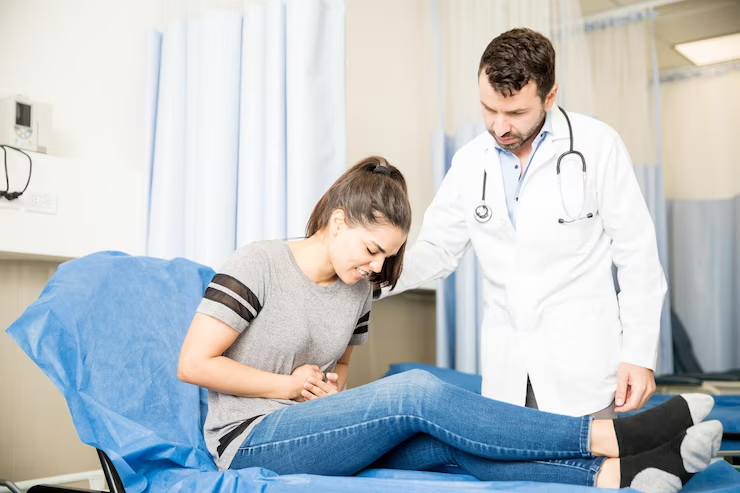
Understanding Diagnostic Procedures: A Guide from a Gastroenterologist in Greater Noida
Gastrointestinal (GI) disorders can be complex and often require a thorough and precise diagnosis to determine the best course of treatment. A Gastroenterologist in Greater Noida uses a variety of diagnostic procedures to identify the root causes of symptoms like abdominal pain, bloating, and changes in bowel habits. This blog will explore some of the most common diagnostic tests performed by gastroenterologists, how they are conducted, and their significance in the treatment process.
1. Endoscopy
Endoscopy is one of the most widely used diagnostic procedures in gastroenterology. It involves the use of an endoscope—a thin, flexible tube with a light and camera at the end—to examine the inside of the digestive tract.
- Procedure:
- The patient is usually sedated.
- The endoscope is gently inserted through the mouth to examine the esophagus, stomach, and upper part of the small intestine (upper GI endoscopy).
- A lower GI endoscopy, known as a colonoscopy, is performed through the rectum to view the large intestine.
- Purpose:
- To investigate symptoms such as persistent heartburn, swallowing difficulties, unexplained weight loss, or chronic diarrhea.
- To diagnose conditions like GERD, ulcers, Crohn’s disease, and colorectal cancer.
- To perform biopsies or remove polyps during the procedure.
Endoscopy is a critical tool for a Gastroenterologist in Greater Noida as it allows for direct visualization of the GI tract, aiding in accurate diagnosis and treatment planning.
2. Colonoscopy
A Colonoscopy is a specific type of endoscopy that focuses on the large intestine and rectum. It is essential for detecting abnormalities like polyps, inflammation, or cancer.
- Procedure:
- The patient undergoes bowel preparation to clear the colon.
- Sedation is provided for comfort.
- The endoscope is inserted through the rectum to examine the entire colon.
- Purpose:
- To screen for colorectal cancer, especially in individuals over 50 or those with a family history of the disease.
- To investigate chronic abdominal pain, changes in bowel habits, and rectal bleeding.
- To remove polyps that could potentially develop into cancer.
A Gastroenterologist in Greater Noida may recommend a colonoscopy as a preventive measure or in response to specific symptoms, helping to catch and treat conditions early.
3. Capsule Endoscopy
Capsule Endoscopy is a cutting-edge diagnostic procedure that involves swallowing a small, pill-sized camera that takes thousands of images as it travels through the digestive tract.
- Procedure:
- The patient swallows a capsule containing the camera.
- As the capsule moves through the digestive system, it captures images that are transmitted to a recording device worn by the patient.
- The capsule is naturally excreted, and the images are reviewed by the gastroenterologist.
- Purpose:
- To examine the small intestine, which is difficult to reach with traditional endoscopy.
- To diagnose conditions such as Crohn’s disease, small bowel tumors, and unexplained GI bleeding.
- To monitor the progression of known conditions.
Capsule endoscopy is particularly useful for providing a comprehensive view of the small intestine, which is otherwise challenging to examine. A Gastroenterologist in Greater Noida may use this technology to gain insights into complex cases.
4. Esophageal Manometry
Esophageal Manometry is a diagnostic test that measures the pressure and muscle contractions in the esophagus, helping to diagnose conditions that affect swallowing and reflux.
- Procedure:
- A thin, flexible tube is passed through the nose, down the esophagus, and into the stomach.
- The patient swallows while the tube measures the pressure exerted by the esophageal muscles.
- The test typically lasts about 30 minutes and is performed without sedation.
- Purpose:
- To diagnose motility disorders such as achalasia or diffuse esophageal spasm.
- To assess the function of the lower esophageal sphincter in patients with GERD.
- To determine the cause of unexplained chest pain or difficulty swallowing.
Esophageal manometry provides critical information about the functional status of the esophagus. A Gastroenterologist in Greater Noida may recommend this test when structural abnormalities are ruled out, but symptoms persist.
5. Breath Tests
Breath Tests are non-invasive diagnostic tools used to detect certain conditions based on the presence of specific gases in the breath.
- Procedure:
- The patient ingests a substrate (such as lactose or glucose) and breathes into a collection device at regular intervals.
- The breath samples are analyzed for the presence of gases like hydrogen or methane, which can indicate bacterial overgrowth or carbohydrate malabsorption.
- Types:
- Lactose Intolerance Test: Determines whether the patient can digest lactose properly.
- Small Intestinal Bacterial Overgrowth (SIBO) Test: Detects an overgrowth of bacteria in the small intestine.
- H. pylori Test: Identifies the presence of Helicobacter pylori, a bacteria associated with ulcers.
- Purpose:
- To diagnose conditions like lactose intolerance, SIBO, or H. pylori infection, which can cause symptoms such as bloating, gas, and diarrhea.
- To tailor treatment plans based on the specific condition identified.
Breath tests are simple, yet effective diagnostic tools. A Gastroenterologist in Greater Noida may use these tests to diagnose and manage various gastrointestinal conditions, especially when non-invasive methods are preferred.
6. Abdominal Ultrasound
Abdominal Ultrasound is an imaging test that uses sound waves to produce images of the organs and structures in the abdomen.
- Procedure:
- A gel is applied to the abdomen, and a transducer is moved over the skin to capture images.
- The procedure is painless and non-invasive, typically taking about 30 minutes.
- Purpose:
- To visualize the liver, gallbladder, pancreas, kidneys, and other abdominal organs.
- To detect gallstones, liver disease, tumors, or other abnormalities.
- To guide needle biopsies or other interventional procedures.
Abdominal ultrasound is a first-line imaging test that provides valuable information about the state of abdominal organs. A Gastroenterologist in Greater Noida may recommend this test as part of a comprehensive diagnostic evaluation.
7. Barium Swallow and Barium Enema

Barium Swallow and Barium Enema are specialized X-ray procedures used to examine the upper and lower gastrointestinal tract.
- Procedure:
- Barium Swallow: The patient drinks a barium solution that coats the lining of the esophagus, stomach, and small intestine. X-rays are taken to visualize the digestive tract.
- Barium Enema: Barium is introduced into the colon through the rectum, and X-rays are taken to examine the large intestine.
- Purpose:
- To diagnose structural abnormalities such as strictures, blockages, or tumors.
- To assess the cause of swallowing difficulties, abdominal pain, or chronic diarrhea.
- To plan for surgical procedures or further diagnostic tests.
These tests are essential for identifying issues that may not be visible through endoscopy or ultrasound. A Gastroenterologist in Greater Noida might use barium studies to complement other diagnostic procedures.
FAQs
- What is the most common diagnostic procedure in gastroenterology?
- Endoscopy is one of the most common and versatile diagnostic procedures in gastroenterology, allowing direct visualization and biopsy of the digestive tract.
- How should I prepare for a colonoscopy?
- Preparation for a colonoscopy typically involves following a clear liquid diet and taking laxatives the day before the procedure to cleanse the colon.
- Are diagnostic tests in gastroenterology painful?
- Most diagnostic tests, such as endoscopy and manometry, are performed with sedation or are minimally invasive, ensuring patient comfort.
- What conditions can be diagnosed with breath tests?
- Breath tests can diagnose conditions like lactose intolerance, small intestinal bacterial overgrowth (SIBO), and H. pylori infection.
- When should I see a gastroenterologist for diagnostic testing?
- You should see a gastroenterologist if you experience persistent or severe gastrointestinal symptoms such as abdominal pain, bloating, changes in bowel habits, or unexplained weight loss.
Conclusion
Accurate diagnosis is the cornerstone of effective treatment for gastrointestinal disorders. The diagnostic procedures performed by a Gastroenterologist in Greater Noida are designed to identify the root cause of symptoms and guide the development of a personalized treatment plan. From endoscopy to breath tests, each procedure plays a crucial role in ensuring patients receive the care they need. Regular screenings and early diagnosis can significantly improve outcomes, making it essential to consult with a gastroenterologist when symptoms arise.





Leave Your Comment